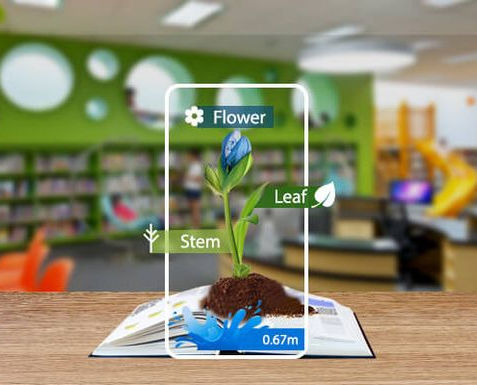Augmented Reality in STEM articles

Elementary School -Teaching botany with augmented reality
Chien et al. (2017;2019) used AR-based learning material to enhance the learning experience of 54 third-grade students by providing them with multiple views of different plants that the children were studying as part of their science curriculum. The learning outcomes when using AR technology were then assessed using Bloom’s Taxonomy by measuring the students’ degree of learning at each level. The results of this study show that the students observing the plants through AR showed significantly greater comprehension compared to those students who did not get to use the AR technology. Therefore, the study concludes that AR-based botany learning could significantly enhance the students’ learning abilities in higher level of thinking (Chien et al., 2017;2019).

High School - Medical surgery lessons using AR
In the Hsu et al. (2017) study, 32 high school seniors participated in two AR lessons on medical surgery. After the lessons were presented to the students, Hsu et al. (2017) measured the students’ level of interest in STEM careers. The results of this study found that student interest and engagement showed high levels of positive perception towards STEM. At the end of this study, Hsu et al. (2017) also found that the AR lessons did make students gain more interest in pursuing a future career in STEM after high school.

K-12 | All levels - Using AR as a learning tool
According to Thornton et al. (2012), AR technology should not only be implemented in STEM education, but across all subjects since AR technology has the potential to help students design a variety of objects and visual models and therefore improve learning in many subjects. Through the use of AR technologies, students also get motivated by seeing their own design models and objects projected in such a realistic form. According to Thornton et al. (2012), the development and implementation of AR technology in education presents many possibilities which can positively impact student learning and motivation.

Elementary School - AR-based learning to enhance science reading performance
According to Lai et al. (2019), reading is a very important skill for learning science and enhancing students’ competence in science education. Therefore, Lai et al. (2019) developed an AR-based learning system for science based on the contiguity principle of multimedia in order to enhance student learning. Their study was conducted in an elementary school to assess the system’s effectiveness on student learning and they found that students learning with AR technology made significant progress in learning and motivation, compared to those that learned the traditional way. The results of this study demonstrated the potential advantages of AR technology in science reading.

High School - Scientific Imagineering learning process using AR
Techkosit and Nilsook (2016), developed a learning process of scientific imagineering using AR technology to enhance STEM literacy. The scientific imagineering process through AR consists of the following steps: imagine, study and research, design, develop, present, and evaluate (Techkosit & Nilsook, 2016). The steps in the learning process are meant to help students gain a better understanding of complex processes presented in STEM literacy. According to the evaluation from experts in the field, it is strongly agreed that the use of this scientific imagineering process through AR can help develop STEM literacy (Techkosit & Nilsook, 2016).

.png)



